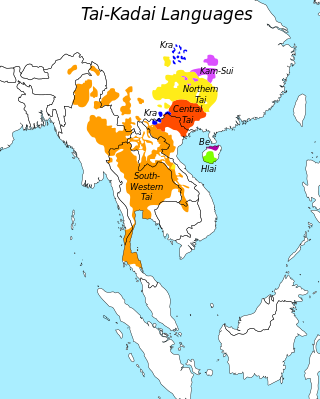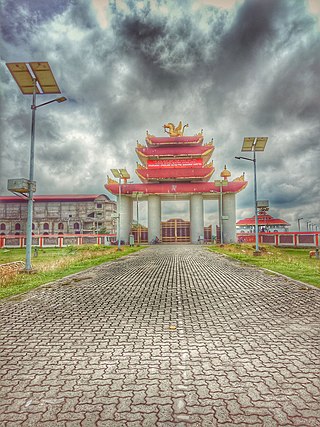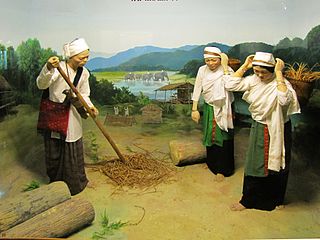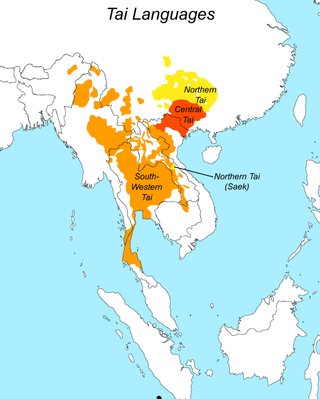
Assam is a state in northeastern India, south of the eastern Himalayas along the Brahmaputra and Barak River valleys. Assam covers an area of 78,438 km2 (30,285 sq mi). It is the second largest state in northeastern India by area and the largest in terms of population. The state is bordered by Bhutan and Arunachal Pradesh to the north; Nagaland and Manipur to the east; Meghalaya, Tripura, Mizoram and Bangladesh to the south; and West Bengal to the west via the Siliguri Corridor, a 22-kilometre-wide (14 mi) strip of land that connects the state to the rest of India. Assamese and Boro are the official languages of Assam. Meitei (Manipuri) is the official language of Hojai district and the entirety of the Barak Valley districts, while Bengali is an official language in the three districts of Barak Valley.

The Shan people, also known as the Tai Long or Tai Yai, are a Tai ethnic group of Southeast Asia. The Shan are the biggest minority of Burma (Myanmar) and primarily live in the Shan State of this country, but also inhabit parts of Mandalay Region, Kachin State, Kayah State, Sagaing Region and Kayin State, and in adjacent regions of China, Laos, Assam and Meghalaya, Cambodia, Vietnam and Thailand. Though no reliable census has been taken in Burma since 1935, the Shan are estimated to number 4–6 million, with CIA Factbook giving an estimate of five million spread throughout Myanmar which is about 10% of the overall Burmese population.

The term Kra–Dai peoples or Kra–Dai-speaking peoples refers collectively to the ethnic groups of southern China and Southeast Asia, stretching from Hainan to Northeast India and from southern Sichuan to Laos, Thailand and parts of Vietnam, who not only speak languages belonging to the Kra–Dai language family, but also share similar traditions, culture and ancestry.

The Dai people are several Tai-speaking ethnic groups living in the Xishuangbanna Dai Autonomous Prefecture and the Dehong Dai and Jingpo Autonomous Prefecture of China's Yunnan Province. The Dai people form one of the 56 ethnic groups officially recognized by the People's Republic of China. By extension, the term can apply to groups in Laos, Vietnam, Thailand and Myanmar when Dai is used to mean specifically Tai Yai, Lue, Chinese Shan, Tai Dam, Tai Khao or even Tai in general. For other names, please see the table below.

The Ahom or Tai-Ahom is an ethnic group from the Indian states of Assam and Arunachal Pradesh. The members of this group are admixed descendants of the Tai people who reached the Brahmaputra valley of Assam in 1228 and the local indigenous people who joined them over the course of history. Sukaphaa, the leader of the Tai group and his 9,000 followers established the Ahom kingdom, which controlled much of the Brahmaputra Valley in modern Assam until 1826.

The Ahom language or Tai-Ahom language is a dead language, that was formerly spoken by the Ahom people, but which is currently undergoing a revival. Ahom is an important language in Tai studies. It was relatively free of both Mon-Khmer and Indo-Aryan influences and has a written tradition dating back to the 13th century.
The Indian state of Arunachal Pradesh has a total population of roughly 1.4 million on an area of 84,000 km2, amounting to a population density of about 17 pop./km2. The "indigenous groups" account for about two thirds of population, while immigrants, mostly of Bengali/Hindi belt origin, account for the remaining third.
Laotian Canadians, are Canadian citizens of Laotian origin or descent. In the 2016 Census, 24,580 people indicated Laotian ancestry. Bilateral relations between Canada and Laos were established in 1954 with the formalization of the independence of the Kingdom of Laos from France. In August 2015, Canada's first resident diplomat opened the Office of the Embassy of Canada in Vientiane, Laos.

The largest of the ethnic groups in Cambodia are the Khmer, who comprise 95.8% of the total population and primarily inhabit the lowland Mekong subregion and the central plains. The Khmer historically have lived near the lower Mekong River in a contiguous arc that runs from the southern Khorat Plateau where modern-day Thailand, Laos and Cambodia meet in the northeast, stretching southwest through the lands surrounding Tonle Sap lake to the Cardamom Mountains, then continues back southeast to the mouth of the Mekong River in southeastern Vietnam.

The Khamyang (Tai-Khamyangs or Shyam), is a subgroup of the Tai peoples of Southeast Asia. They are numerically a small indigenous group found in Tinsukia, Jorhat, Sivasagar and Golaghat districts of Assam, and adjacent parts of Arunachal Pradesh. Their population totals about 7,000, of which only a small minority speak the native Tai Khamyang language while the vast majority speak the Assamese language. The Khamyang are followers of Theravada Buddhism and are closely related to the Khamti. They maintain good relations with other Tai Buddhist tribes of Assam.

The Tai Khamti, also known as the Hkamti Shan or simply as Khamti, are a Tai ethnic group of India, China and Myanmar. The Tai-Khamti are followers of Theravada Buddhism. The Tai-Khamti have their own script for their language, known as 'Lik Tai', which originated from the Shan (Tai) script of Myanmar. Their mother tongue is known as Khamti language. It is a Tai language, closely related to Thai and Lao.

The People of Assam inhabit a multi-ethnic, multi-linguistic and multi-religious society. They speak languages that belong to four main language groups: Tibeto-Burman, Indo-Aryan, Tai-Kadai, and Austroasiatic. The large number of ethnic and linguistic groups, the population composition, and the peopling process in the state has led to it being called an "India in miniature".
Khamyang is a critically endangered Tai language of India, spoken by the Khamyang people. Approximately fifty people speak the language; all reside in the village of Powaimukh, located seven miles downstream of Margherita in the Tinsukia district. It is closely related to the other Tai languages in the Assam region: Aiton, Khamti, Phake, and Turung.
The Turungpeople or Tai Turung, are a numerically small Buddhist community in the northeastern Indian state of Assam. They speak their own Turung language.

Tai peoples are the populations who speak the Tai languages. There are a total of about 93 million people of Tai ancestry worldwide, with the largest ethnic groups being Dai, Thais, Isan, Tai Yai (Shan),Tai Lai (Shanni), Lao, Tai Ahom, Tai Meitei and Northern Thai peoples.

The Southwestern Tai or Thailanguages are a branch of the Tai languages of Southeast Asia. Its languages include Central Thai (Siamese), Northern Thai (Lanna), Lao, Shan and others.
The Aiton language or Tai Aiton language is spoken in Assam, India, in the Dhonsiri Valley and the south bank of the Brahmaputra. It is currently classified as a threatened language, with fewer than 2,000 speakers worldwide. Its other names include Aitonia and Sham Doaniya.
The Phake language or Tai Phake language is a Tai language spoken in the Buri Dihing Valley of Assam, India. It is closely related to the other Southwestern Tai languages in Assam: Aiton, Khamti, Khamyang, and Turung.
The Sangken festival is celebrated in Arunachal Pradesh and parts of Assam, India, as the traditional New Year's Day from 14 to 16 April by the Theravada Buddhist Communities. It coincides with the New Year of many calendars. The Sangken festival is celebrated by the Khamti, Singpho, Khamyang, Tangsa tribes of Arunachal Pradesh, and Tai Phake, Tai Aiton, and Tai Turung communities of Assam. Sangken generally falls in the month of 'Nuean Ha', the fifth month of the year of the Tai lunisolar calendar coinciding with the month of April. It is celebrated in the last days of the old year and the New Year begins on the day just after the end of the festival.
The population of Assam consist of tribal ethnic groups and linguistic groups such as Assamese, Bengali, Hindi speakers, Nepali and Odia speakers.












